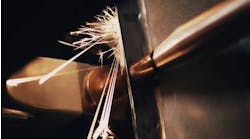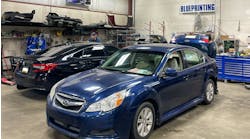Use these five helpful techniques for best seam sealer performance and appearance
Although they don’t draw the same attention as electric vehicles, lightweight materials, and advanced driver assistance systems (ADAS,) seam sealers perform the important function of preventing, primarily, water leaks and corrosion in the joints, but also fumes, air movement and road noise.
To achieve proper sealing performance and a factory-like appearance, it’s critical that technicians select the proper products and know how to use them. Ryan Marrinan, Senior Application Engineer for 3M Automotive Aftermarket Division, spoke with ABRN about techniques that will provide the best seam sealer performance and appearance.
1) There is not a one-size-fits-all product for every repair
Technicians should understand the portfolio of a manufacturer’s products and how they should be applied in different areas of the vehicle for optimum performance and appearance, Marrinan said. 3M salespeople use a demo board on which there are 16 different applications using 12 unique products. Although most shops can reduce their stock to a few key products in most cases, the board helps illustrate the different toolability of each product and the various techniques that can be employed to best match different OEM appearances. Even on the same vehicle, there may be multiple seam sealer types and looks that will require a few different products.
One example, Marrinan said, is selecting a self-leveling sealer (which is very flowable) for a roof ditch, when a controlled flow sealer would be better suited to the need. The controlled flow sealer will allow the technician to build up the sealer to the larger depth required.
2) Use available nozzle tips – or form your own
Tips that attach to seam sealer cartridge nozzles to better replicate the OEM sealer bead have been available for about a decade, Marrinan said, but they’ve recently become popular. Technicians can also use a pair of duckbill Vise-Grips to shape the tip of a disposable nozzle to match the OEM sealer bead more closely.
3) How to successfully re-use the old seam sealer bead
But sometimes, no matter what tricks are employed, whether it’s using an old ScotchBrite pad, an air blow gun, or special cartridge tips, nothing beats the original – even if it’s a piece of seam sealer carefully removed with a knife and saved for reuse. But there are caveats to that method to ensure the reused piece works with new seam sealer to perform like new.
“These beads that technicians are trying to replicate are done by robots, and there are some beads that, no matter what you produce, you just cannot replicate them to a tee. So, if they're able to trim those off and keep them clean, using a seam sealer to reattach them is acceptable.”
Ensuring optimum performance means making sure all edges are sealed correctly and the old piece of seam sealer is prepped correctly. Clean the sealed joint with soap and water and then a wax-and-grease remover, and then scuff the surface with a scuff pad prior to removal. Then carefully trim it from the old panel and store it in a plastic bag to keep it free of contaminants. Once it’s ready to be reinstalled, Marrinan recommends sealing the joint for sealing performance and then installing the reused seam sealer by “wetting out” the back of it with new seam sealer and pressing it into place, which will result in some squeeze-out of the new seam sealer. After that sets up, “tool in” the new material with a tool, brush, or gloved finger to make sure there are no voids around the original seam sealer that would allow moisture to creep in.
4) The proper technique for making a new seam sealer piece on the bench for application on the vehicle
Similar to reusing a piece of old seam sealer, sometimes it’s necessary to produce a piece of new seam sealer on the workbench or tool cart. Limited access to the repair area or awkward application angles may prevent getting the applicator gun in the correct spot.
“By building it on a bench, you’re able to easily replicate the original-looking appearance but then also apply it to the vehicle without any struggle. We recommend using cellophane packing tape [as the backer], because there’s sort of a built-in release liner on that tape; seam sealer doesn’t stick to it, but there are no chemicals or contaminants being picked up into the seam sealer that would cause a problem with bonding it to the vehicle afterward,” Marrinan said.
The new seam sealer is then allowed to cure and is removed from the tape just prior to application. Installing the newly created piece of seam sealer requires the same steps as reusing the old piece of seam sealer: apply new sealer into the joint with a gloved finger or acid brush. Then “butter” the cured seam sealer with new sealer and press into place, using a gloved finger or acid brush to ensure the squeeze-out is properly cured.
5) Some common application errors
As Marrinan pointed out earlier, it’s important to use wax-and-grease remover to ensure a clean surface. Some technicians will also use the same solvent to assist with tooling a seam. But they should be sure they’re not overapplying, which will result in a loss of adhesion.
“A lot of times, technicians will flood the surface of the vehicle and then try to wipe it off. So, they’re spraying it onto the vehicle, and then they’re trying to wipe it clean,” he said. “What happens is some of those cleaners are wicking into the seam that we’re just about to apply seam sealer to. And when they apply the seam sealer, that wet adhesive remover is still in there, and that’s going to cause adhesion problems behind the seam sealer.”
The same issues can result from overusing a solvent over the top of the freshly applied sealer.
“In some cases, we, recommend using our General Purpose Adhesive Cleaner as a final tooling aid to help smooth the appearance. However, we cannot wet out the surface of the seam sealer. We’re just applying a light spray, say on a ScotchBrite pad, a mud spreader, or a gloved hand or finger to smooth if off after the initial tooling work has been done, as sort of a final step.”
As part of his duties, Marrinan is sometimes called upon to help solve product problems.
“In yesterday’s inquiry, they had applied a one-part seam sealer in a roof ditch, and they tooled it out. But then they poured General Purpose Adhesive Cleaner over the top of it and tried to get it to smooth out. Well, those solvents soaked into the surface and caused it to not cure properly. So, after 48 hours, they were touching it and it was still gummy.”
It’s a technician’s nature to find solutions to problems he or she encounters in the field. But if he or she is unsure of the suitability or performance of a new application for a product, the manufacturer or their representative can offer insight, Marrinan said. As is the case with other procedures, deviating from them can result in performance problems, such as improper curing or a weak bond to the substrate.
“Part of our job is to identify these new opportunities for these applications,” he said. “If it’s something that is doable, we can provide additional testing to validate and substantiate the use of the product in that type of situation.”
***





